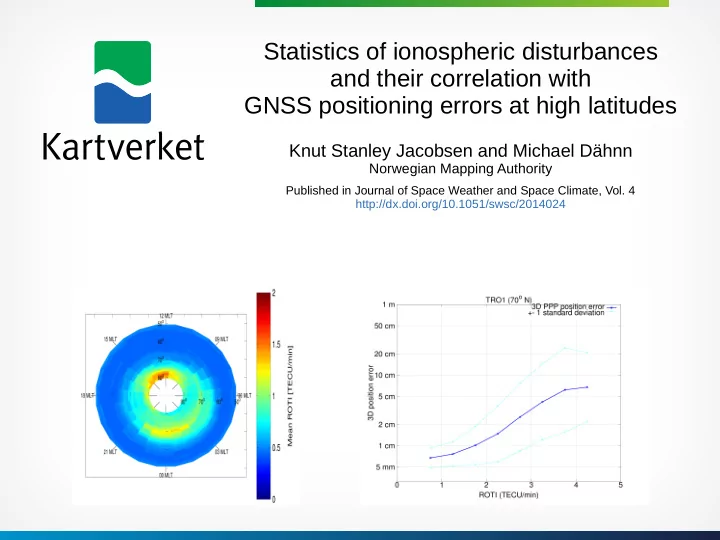

Statistics of ionospheric disturbances and their correlation with GNSS positioning errors at high latitudes Knut Stanley Jacobsen and Michael Dähnn Norwegian Mapping Authority Published in Journal of Space Weather and Space Climate, Vol. 4 http://dx.doi.org/10.1051/swsc/2014024
Data source ● 9 GNSS receivers, 1 Hz sample rate ● Time period: 2012 (the entire year)
Calculations Every 5 minutes, for each satellite observed by each receiver, we calculated: ● ROTI (A measure of ionospheric disturbance level) ● Standard deviation of Rate-of-TEC ● 3D position ● Calculated using GIPSY The 3D position error was calculated by taking the difference between the instantaneous values of the coordinate time series and its median value, after removing the linear trend from the coordinate time series by subtracting it's linear fit for the year. Geomagnetic coordinates were calculated for all measurement points, using AACGM.
Relevant space weather regions at high latitudes ● The Auroral Oval ● The Polar Cusp
Amount and distribution of measurements ● 10.3 million satellite measurement points ● 0.94 million receiver coordinates
Result 1 – ROTI vs Elevation ● At elevations below 30 degrees, the value of ROTI depends strongly on elevation. The value of ROTI increases exponentially with the length of the signal path through the atmosphere. ● At elevations above 40, other effects dominate over the elevation dependence.
Result 2 – ROTI occurrence statistics (In geomagnetic coordinates) Elevated ROTI values occur mainly in Enhanced ROTI values most commonly occur in the cusp region, but the cusp region and in the nightside when they occur in the nightside auroral oval, they are higher. auroral oval. Mean ROTI Percentage of observations Percentage of observations all observations included with ROTI >= 3.5 with ROTI >= 5
Calculations Characterizing the connection between ROTI and position error
Result 3 – The connection between ROTI and position error
Result 3 – The connection between ROTI and position error ID Latitude Corr. coeff. b NYAL 78.93 0.46 1.67 NYA1 78.93 0.39 0.75 LYRS 78.23 0.47 0.99 HAMC 70.67 0.66 0.88 TRO1 69.66 0.67 1.02 VEGS 65.67 0.49 0.9 FOLC 64.12 0.41 0.83 HFS4 60.14 0.09 0.13 OPEC 59.91 0.14 0.24 STAS 59.02 0.16 0.31 PosErr 3D, 1h = a * e (b * ROTI Avg, 1h )
Result 4 – Risk of simultaneous disturbance
Conclusions ● PPP position error is strongly correlated with ROTI. ● PPP position error increases exponentially with ROTI. ● At elevations below 30 degrees, the length of the signal path through the atmosphere is the dominating factor for the average ROTI value. ● Elevated ROTI values occur mainly in the cusp region and in the nightside auroral oval. ● Enhanced ROTI values most commonly occur in the cusp region, but when they occur in the nightside auroral oval, they are higher. ● The risk of having multiple satellites simultaneously disturbed is greater at higher latitudes.
Recommend
More recommend